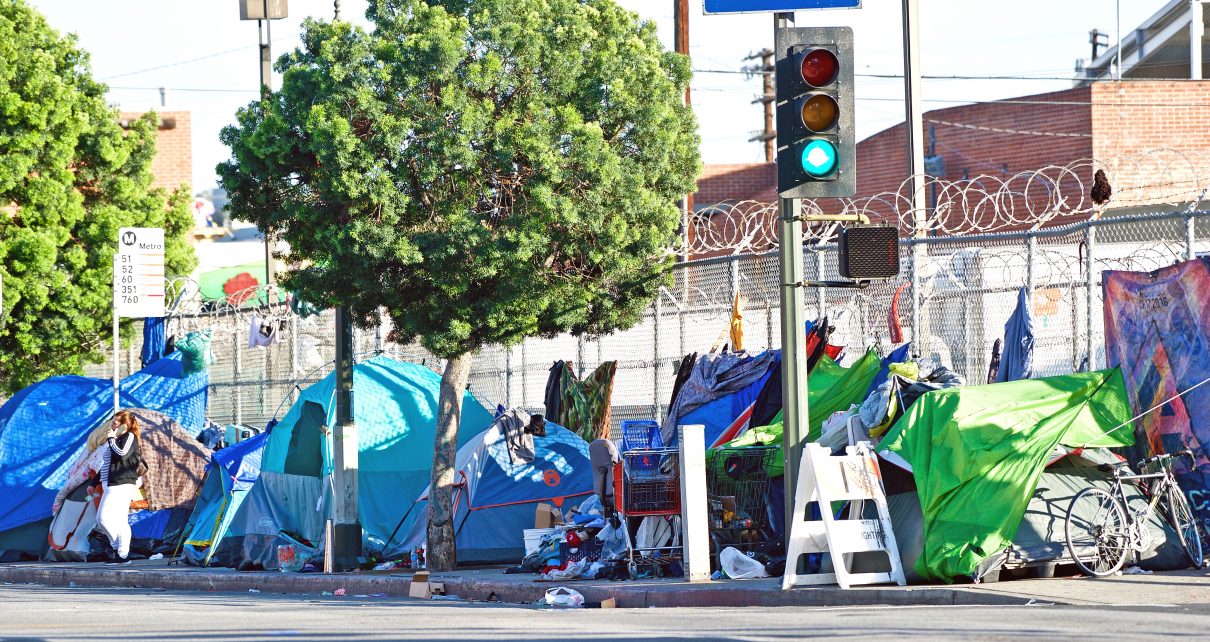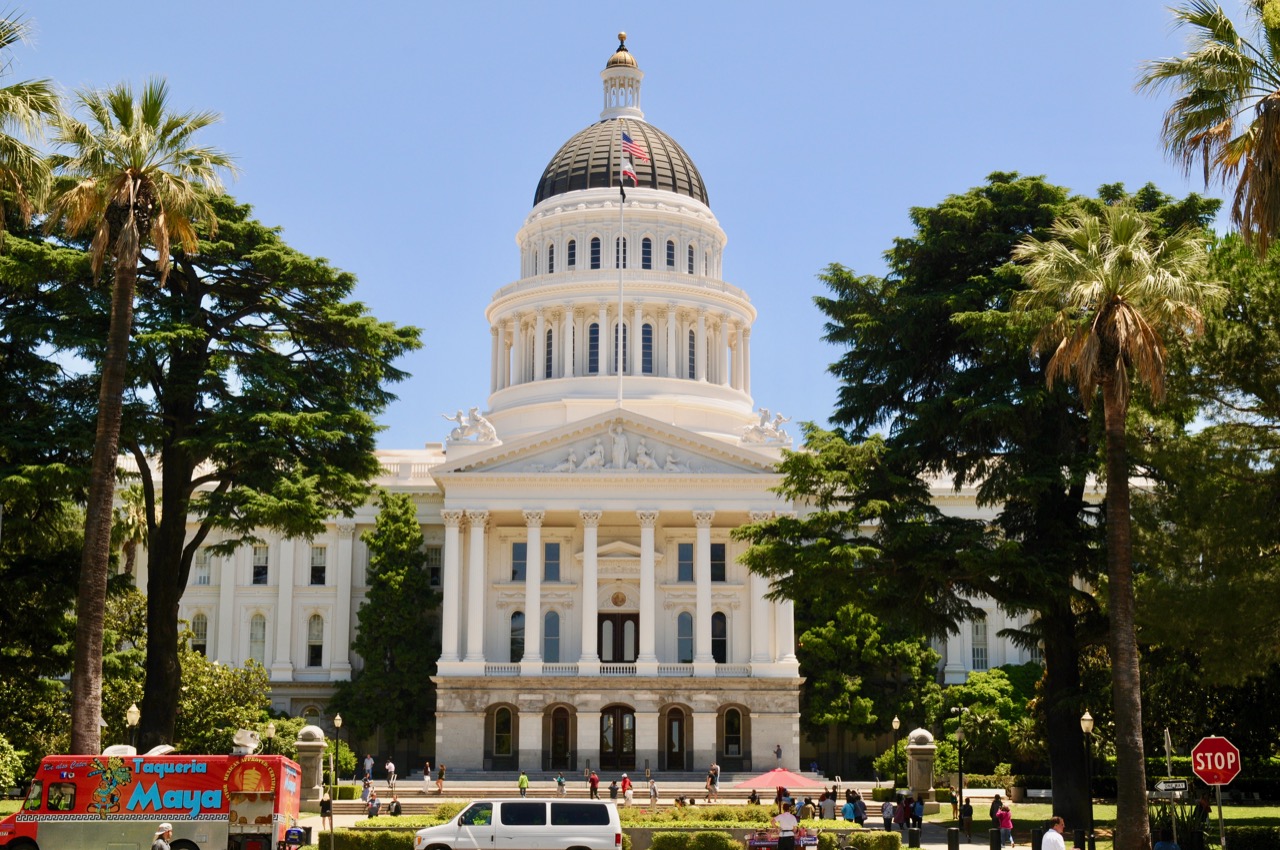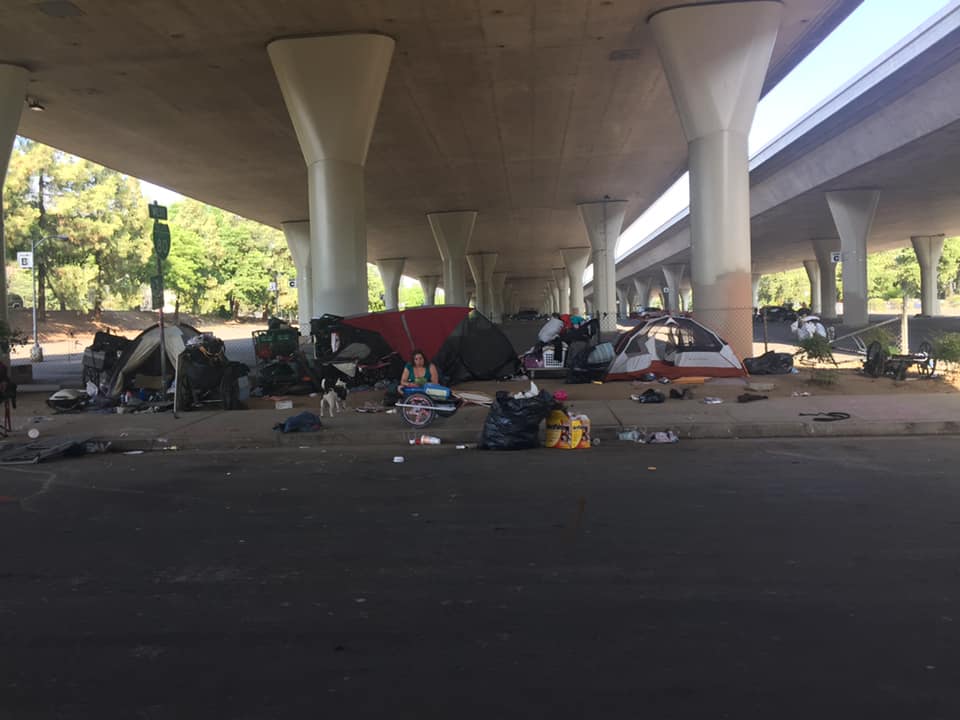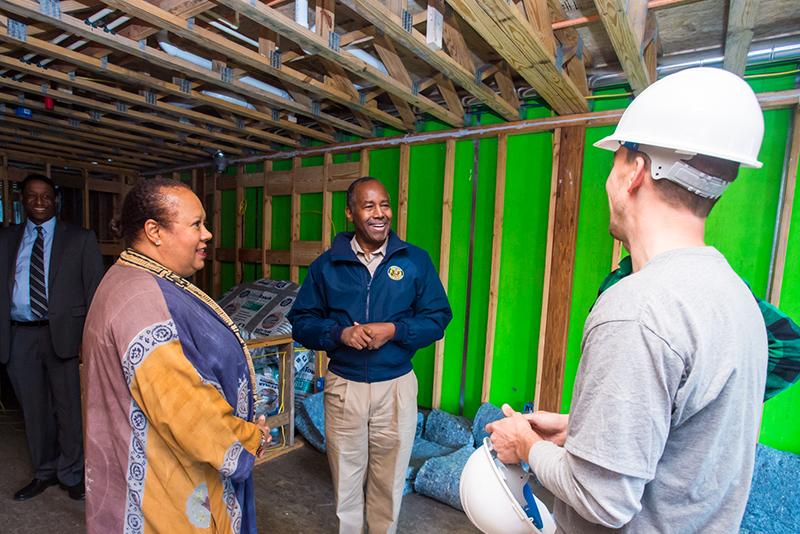
Homeless encampment along the roadside depicting the growing epidemic of homelessness (Photo: Philip Pilosian/ Shutterstock)
The Real Cost of Permanent Supportive Housing for California’s Homeless
The annual value-benefit figure equivalent to having a job that pays about $19 per hour and includes health benefits.
By Thomas Buckley, February 16, 2022 8:02 am
As government agencies around the state have begun to build permanent supportive housing (PSH) projects for California’s estimated 160,000 homeless people, much attention has been focused on the cost of these programs.
Not much attention has been paid to the economic value of permanent supportive housing to the participant, a figure that could – when including medical coverage, free and/or subsidized rent, direct cash payments, etc., – run up to about $40,000 per person per year. That cost – covered by various government agencies at the local, state, and federal level – would mean that if Los Angeles were to house all of its estimated 70,000 homeless people in permanent supportive housing the value to the residents could be about $2.8 billion per year, or more than $6 billion statewide.
To put the size of the effort into local perspective, if permanent supportive housing advocates get their wish and every Los Angeles-based homeless person got an apartment that would mean creating more units than are currently held by The Irvine Company.
The annual value-benefit figure – which is an approximation and may vary from person-to-person and from project to project – is about the same as California’s median per capita income and could provide a standard-of-living equivalent to having a job that pays about $19 per hour and includes health benefits.
So what can a resident of a permanent supportive housing project expect to receive? Let’s start with the housing part of permanent supportive housing.
While there is not an over-abundance of 500 square-foot rental units available in Los Angeles, the typical monthly rent for a housing equivalent to a permanent supportive housing apartment is about $1,400 per month (again, there are variables such as utility inclusion, etc.).
That figure may not tell the whole story, especially when juxtaposed to the amount of money being spent per unit.
In Los Angeles, for example, the capital costs associated with each dwelling unit have been north of $600,000 each in many cases (this figure applies to new construction; the figures for projects like motel conversions are running about 50 to 70 percent of that figure). If the entire need were covered, that would entail a capital expense of about $42 billion.
This amount alone is causing much concern, especially considering exactly what is being built. In many cases, this per-unit cost covers what is essentially an efficiency/studio apartment in the 500 square-foot range, or about $1,200 per foot. This does include hallways, meeting rooms, offices, parking (largely bicycle-oriented), but it also includes other costs such as significant – it some cases higher than private industry standards – developer fees, soft costs that include marketing for some inexplicable reason, permitting, land acquisition, etc.
One of the reasons the costs are so high is due to the “prevailing wage” standard being applied. At some time long ago, the idea of prevailing wage – paying people no less than they would get on for private work – was put in place to ensure government contracts were not given out to purposefully lowball bidders (and/or skeezy relatives of the elected officials). It has since come to mean that, in practice, government project labor costs are about 30 percent higher than in the private sector as the “prevailing wage” is now, for whatever reason, far higher than average, or prevailing if you will, private sector pay.
That difference, however, does not make up the entire extra costs that seem to be involved in permanent supportive housing projects. For example, at least one project is Phoenix is coming in at about $350 per square-foot. Even doubling that figure to account for higher land and construction costs in Los Angeles and the creation of different project types (high-rise versus low-rise, etc.) still means permanent supportive housing projects in LA are costing well more than contemplated.
But what if it was simply decided – at the outset – the figure was going to be $600,000 per unit – what would that build in the private sector? Depending upon location (which is important), a typical apartment project in the Los Angeles metro area built at that cost would feature units – on average – of about 1,100 square-feet, or more than twice the size. The same holds true, roughly, for condominiums, and as for houses a buyer could expect – in the Inland Empire – about a four bedroom, 3,000 square-foot home on a decent lot in a nice community.
Houses or condos built for that $600,000 figure would retail for about $725,000 (developers contacted for this story say) with a mortgage in the $2,800 per month range (that figure varies widely from person-to-person), while apartments would need to rent for about $3,500 per month to cover the project costs.
Therefore, while the value of the rent to the resident is only $1,400 per month, the value of the costs associated with the program more than double that amount (it should be noted that it is possible the housing portion will be operated under some type of federal housing voucher program, many of which call for an individual to pay a portion of their personal income – 10 to 30 percent – towards their housing. However, as LAHSA made itself unavailable for comment exactly how the “rent” – which presumably must exist to pay for on-going operational and maintenance costs – will be divvied up/figured out, charged and/or not charged, etc. is not known at this time).
This figure does not take into consideration the value of the “supportive” part of permanent supportive housing. Many – if not most – of the stand-alone newly-built PSH projects will include office space for case managers, visiting health care providers, job training, etc. and being able to simply take an elevator to one’s doctor’s appointment is hard to put a value on. Additionally, project staffing operational budgets are, at this point, mostly speculative and/or unavailable. However, the set-up could be compared to “independent senior living” facilities that run in the $4,000 per month range as they provide similar levels of on-site services, so it can be assumed a reasonable value figure would be about 15 percent or $600 per month.
As to health care, presumably the vast majority, if not all, of the residents will be either on Medi-care or, far more likely, Medi-Cal. The per-person cost to taxpayers of Medi-Cal is, according to the state’s Legislative Analyst’s Office, is about $550 per month (Medi-Cal does have certain accessibility limitations – not every doctor takes the insurance – but the benefits available under the program are quite comparable to a decent private health insurance policy).
Most if not all permanent supportive housing residents would receive some form of direct assistance, ranging from CalWorks (a welfare-to-work program that pays about $750 per month) to Social Security disability payments (about $950 per month) to other benefits (standard Social Security, veteran’s benefits, etc.)
Permanent supportive housing residents will also be able to avail themselves of CalFresh (food stamps) at about $124 per month and subsidized cell plans (colloquially known as Obamaphones) worth about $50 per month.
Therefore, the total value of services to at least a large swath of PSH residents will run about $3,300 a month – hence the $40,000 per year figure (it should also be noted that many homeless people do currently receive some of the above noted benefits and that figure may not reflect “new” spending).
Considering the capital costs, bonds, tax credits offered to developers, and other possible expenditures are not figured into that personal value figure, exactly what the taxpayer cost per person is not known. It is also not clear how “permanent” the permanent part of permanent supportive housing will turn out to be. Many permanent supportive housing models around the nation operate on the concept that permanent means permanent and except for extreme cases involving things like incarceration, the resident can stay indefinitely.
This housing assurance, permanent supportive housing experts argue, is extremely important when it comes to re-integrating into a more typical lifestyle, as when one is homeless it is impossible to plan beyond the next day or even see the point of sobriety (if substance abuse is an issue) if one cannot imagine it making any difference in one’s life. In other words, if you know you are going to be outside, in fear of attack and/humiliation, unsure of procuring food, unable to bathe, etc. for the next 24 hours, why bother to attempt to endure that misery sober?
As to that issue, it is also unclear if none, some, many, most, or all of the permanent supportive housing projects will be “wet” or “dry” (again, information from LAHSA would have been helpful to clarify the issue).
As a concept, PSH does have many supporters and some studies have shown that PSH does in fact help with staying sober/on proper medication/personal cleanliness/regaining a purpose in life. The questions at hand are of practicality – can 70,000 people be housed? – of finances – why are capital and overhead costs seemingly so high – of origin – if a person is not from California, what should the local taxpayer’s burden be – and of sustainability – how long can California continue to pay billions of dollars each year to address the issue?
And, depending upon future political trends, the clock may already be ticking on the last question.
- Benefit Fraud Problems and Solutions - November 7, 2024
- A Little Exit Poll - November 5, 2024
- Tomorrow’s Headlines Today! - November 5, 2024





Thank you for this article. It helps to place a dollar figure on what the projected or potential costs would be to are for the homeless. I especially appreciate the figures projected in this article as I have a relative who is on the brink of becoming homeless.
Without tackling the drug, alcohol and mental illness I can only wonder what the condition of this housing will be in short order. Furthermore homeless people understand where they can get free handouts and thus have flocked to cities in the west. I sincerely doubt the state can build fast enough to outstrip demand. If you build they will come.
I live in Hollywood and have an encampment next to me for the past few years. As well as 4 others nearby. All filled with trash/garbage/furniture/over sized tents and rats. This is their destination of choice from near and far, (other parts of state or out of state), as they are advised to come to my neighborhood due to the myriad of services provided different organizations, etc.: nightly food/vouchers for metro/laundry/showers/mobile medical/shelter and access to signing up for welfare/Sec. 8 that is NOT provided elsewhere.
ISSUE: The city of LA has a housing shortage for the working class let alone to house able bodied young homeless. I have seen it all…Those who are lazy and want to live off the grid because they can. To those who have untreated social/mental health issues and can’t work/don’t want to work and are not seeking help they need to become contributing members of society.
KEEP giving EVERYTHING free to ANYONE arriving here and you will NEVER see a reduction of homeless here. And taxpayers WILL NOT continue to support the HOMELESS INDUSTRIAL COMPLEX into perpetuity.
Very much enjoyed this article and the author questioning the validity of “housing first” policies. I work in a homeless shelter, been in social services for 37 years (Probation Officer, drug counselor) and giving the homeless everything with no boundaries/expectations is ridiculous. Housing First is like “harm reduction” nobody is against it including me, but to have no requirements of adults is to be pathologically codependent in my opinion and is making the situation worse not better
I wish